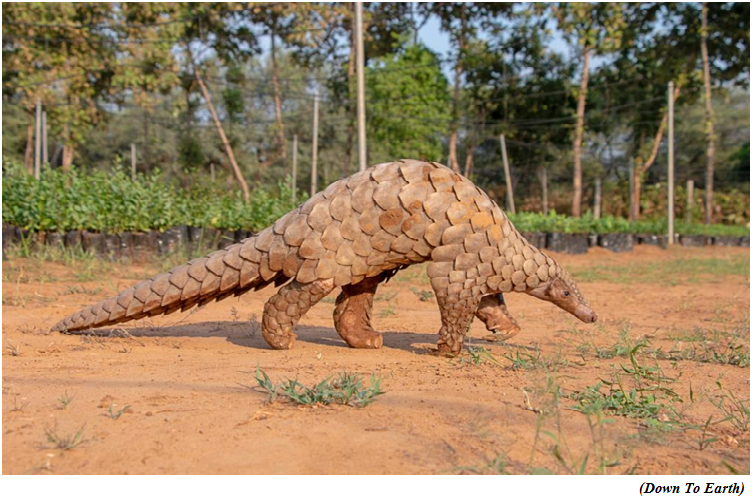Over 1200 pangolins trafficked in India in 5 years Report (GS Paper 3, Environment)

Why in news?
- On the eve of World Pangolin Day observed on February 18, a not-for-profit organisation working on the international trade of animals and plants, has brought out a fact sheet reporting that 1,203 pangolins have been found in illegal wildlife trade in India from 2018 to 2022.
Details:
- Pangolins, their scales and derivatives were recovered in 342 seizure incidents across 24 states and one Union territory of India, according to the analysis by TRAFFIC, a global wildlife conservation non-profit, and World Wide Fund for Nature-India.
- Half of the seizure incidents involved live pangolins and 40 per cent included scales of the animal, which is also called the ‘scaly anteater’.
Status:
- Pangolins are nocturnal, toothless mammals that dig burrows and feed on ants and termites.
- Of the two species found in India, the Indian Pangolin (Manis crassicaudata) is recognised as ‘Endangered’ and the Chinese Pangolin (Manis pentadactyla) as ‘Critically Endangered’ in the International Union for Conservation of Nature List of Threatened Species.
- In India, they are protected by the Wildlife (Protection) Act, 1972 that prohibits its hunting, trade or any other form of utilisation.
- The commercial trade of pangolins was also banned by the Convention on International Trade in Endangered Species of Wild Fauna and Flora in 2017.
Role in ecosystem:
Threat:
- Despite their ecosystem services, they are traded for their demand across the world, mostly in Asia, where their scales are considered to be medicinal and their meat a delicacy.
Way Forward:
- The demand of pangolins in countries where the animal and their byproducts are consumed need to be curtailed, the authors of the report suggested.
- Enforcement actions should be strengthened in India and internationally to deter trade and protect the mammals.
India ranks 4th among 51 countries in having quality entrepreneurship ecosystem: Report
(GS Paper 3, Environment)
Why in news?
- India has been ranked fourth out of 51 countries in having a quality entrepreneurship ecosystem, as per NECI report.
- India's ranking in the Global Entrepreneurship Monitor (GEM) National Entrepreneurship Context Index (NECI) report is a drastic turnaround following a much lower score in 2021, which was 16th overall.

Details:
- India's latest score of 6.1 reflects a steady increase in the country's overall entrepreneurial environment over the years.
- India's NECI score rose from 5.8 in 2019 (ranked 6th among GEM economies) to 6.0 in 2020 (ranked 4th). However, there was a dip in 2021, with a score of 5.0 (barely sufficient) and a rank of 16th.
Key observations:
- The improved quality of the entrepreneurship ecosystem is a reflection of both initiatives of the Indian government in supporting new businesses such as Make in India and Atal Innovation Mission, and a change in popular culture evident through the interest and celebration of entrepreneurship through television shows like Shark Tank India.
- One explanation for the reversing of the trend from 2021 may be that the pandemic was a severe, but temporary, shock to the Indian entrepreneurial environment with all 13 Entrepreneurial Framework Conditions scoring lower in 2021 than in 2020.
Start-ups:
Parameters:
- GEM defines the entrepreneurial context of a particular economy in terms of 13 different characteristics, labelled the Entrepreneurship Framework Conditions (EFCs).
- The NECI results are based on the scores of the framework conditions for each of the participating 51 economies.
- At least 36 experts are selected to assess statements that make up the scores that can be compared across economies.
Indian scientists reveal unique detail about how our Moon evolved
(GS Paper 3, Science and Tech)
Why in news?
- Recently, the scientists at the Physical Research Laboratory in Ahmedabad have found unique evidence pointing to the evolutionary process of the Moon.

Key Findings:
- They found signs of a fundamental shift in the melting process on the Moon between 3.9 to 3.3 billion years ago.
- The new evidence points to the thermal evolution of the Moon as its interior melted in the form of basalt magmatism.
- The new findings challenge currently proposed scenarios for the generation of basalts on the surface, which were found in the samples returned to the Earth by Apollo missions.
Details:
- They found the unique group of ancient lunar basaltic meteorites had a very low abundance of KREEP (potassium, rare-earth elements, and phosphorus).
- This suggests that these meteorites must have come from a region different from the Procellarum KREEP Terrane (PKT) on the Moon and that there could be alternative ways of melting on the Moon.
- The sample return missions have provided the basis for understanding the thermochemical evolution of the Moon. Mare basalt sources are likely to have originated from the partial melting of the lunar magma ocean and then cumulating after solidification from an initially molten state.
- Analysis of the samples demonstrated that these basalts were generated at lower temperatures and shallower depths than typical Apollo mare basalts.
- The Indian Space Research Organisation said that these basalts must be a result of low-pressure melting in the Moon, similar to those in other terrestrial bodies, such as Earth and Mars.
Sources of the study:
- A team of scientists from India, the USA, and Japan have studied samples from lunar meteorite Asuka-881757, which was found in 1988 in Antarctica, lunar meteorite Kalahari 009 found in 1999 at the Kalahari Desert in South Africa, and samples collected by the Russian Luna-24 mission.




